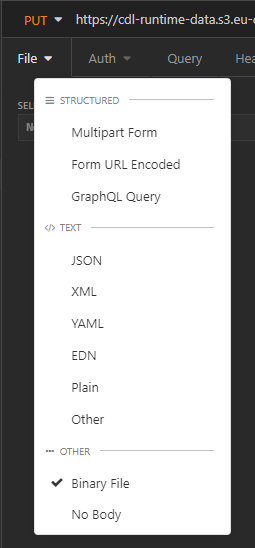Overview
This step-by-step instruction guides the user through the data upload process using Upload Request. Uploaded data can be used with Use Case Enablers.
Scenario
In this instruction, the user will learn how to:
- Create a Data Storage,
- Request a file upload,
- Upload desired data,
- Read uploaded data,
- Delete unused data storage.
Skip this step if a Data Storage was created before. You can use it multiple times for your files. Get the id of your Data Storage and go directly to the Step 2.
To upload desired files, storage is needed! Before upload:
- Use the Create Storage endpoint to send the below request.
- Select the Create a storage example.
- Replace the
dataStorageExampleand thedataSourceExamplewith new names.
{
"name": "dataStorageExample",
"dataSources": [
{
"dataSourceName": "dataSourceExample",
"dataMapperDefinitionId": "61a5d4dc773d1012a3dfa5aa"
}
],
"featuresOn": ["LOOKUP", "DATA_MIRROR"]
}Important information:
- Your storage is created if the
status:CREATED_SUCCESSFULLYis displayed in the response body. - The
idrefers to the unique identifier of a newly created storage (e.g.,id:3a10645d8be23f53a20b30bfa936e63d). - The storage is empty by default.
The Data Storage is successfully created. Use storage id in the next step.
To start the import job of a CSV or XLSX file:
- Use the Request file upload endpoint to send the below request.
- Change the name of the imported file if needed.
{
"url": "file.xlsx"
}In the response, you will find three important parameters:
- The uploadLink with the link to be used in the next step.
- The uploadMethod with the method to be used during the upload.
- The url with the link to your uploaded file.
{
"uploadLink": "https://example.org/some.line",
"uploadMethod": "PUT",
"url": "customer-uploads/cdq/user-id/file.xlsx"
}Use uploadLink and uploadMethod during the upload. Use url in the next step.
The validation of the link is temporary. Upload the file as fast as possible.
Uploading the file must be performed by an external client like Insomnia.
To upload the file:
- Create a new request.
- Set the
uploadMethodand paste theuploadLink.
 |
| Defining the request parameters |
- Change the body of the request to Binary File.
- Select the file.
 |  |
| Setting the request body | Selecting the file |
- Send the request.
No request body expected. Go to the next step.
To start the import job of the uploaded file:
- Use the Start Import Job endpoint to send the below request.
- Paste the existing storage
id. - Paste the
urlfrom step 2.
In the response, you will find three important parameters:
- The id with the value representing
YOUR JOB ID- the unique number of every upload job. - The progress:
0representing the progress of the job. - The status:
SCHEDULED- the job is in the job queue.
Note down received YOUR JOB ID for polling the job status.
To check the import job status:
- Use the Poll Import Job endpoint to send the below request.
- Use the
YOUR JOB IDfrom the previous step and replace thejobId.
If the job is still running, the status with the progress will be displayed:
{
"id": "YOUR JOB ID",
"progress": "71",
"status": "RUNNING"
}The import job runtime is dependent on the size of the imported file. Poll the status regularly to find out when the import is done.
When the job is done, the FINISHED status will be displayed:
{
"id": "YOUR JOB ID",
"progress": "100",
"status": "FINISHED"
}The data is fully imported to your storage now. The uploaded data can be processed now by the wide range of CDQ Solutions.
To read uploaded data:
- Use the Read Business Partners endpoint to send the below request.
- Use the existing storage
id.
In the response, the Business Partners data will be displayed in the value object:
{
"values": [
{
"businessPartnerData1"
},
{
"businessPartnerData2"
}
]
}The businessPartnerData1 and businessPartnerData2 represent the sets of parameters for a particular Business Partner. It is used for simplification.
Good Practices
Delete the storage after you no longer need it.
- Use the Delete Storage endpoint to send the below request.
- Use the existing storage
idno longer in use and replace thestorageIdin the request.
We are constantly working on providing an outstanding user experience with our products. Please share your opinion about this tutorial!